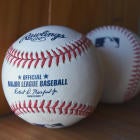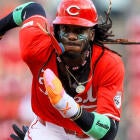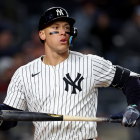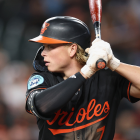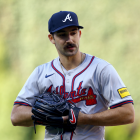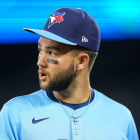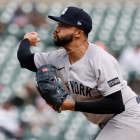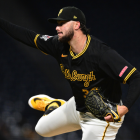Major League Baseball in recent years, and most especially during the 2019 season, has become a power game. For evidence of this stirring claim, look no further than these home run trends over the last half-decade:
| Season | Home runs per team, per game | Total home runs |
|---|---|---|
2014 | 0.86 | 4,186 |
2015 | 1.01 | 4,909 |
2016 | 1.16 | 5,610 |
2017 | 1.26 | 6,105 |
2018 | 1.15 | 5,585 |
2019 | 1.39 | 6,776 |
You'll note the strong upward trajectory since 2014, but that almost undersells what's happened. The top two home run seasons of all-time, in terms of both per-game and season total, are 2017 and 2019. Four of the top five seasons all-time in those categories have come since 2016.
Now take particular note of 2019. There's breaking a record and then there's -- relevant metaphor forthcoming -- slamming it over the fence, the parking lot, and the adjacent eight-lane expressway. That's what the 2019 MLB season did to our notions of the possible when it comes to home run outputs at the team and league levels. As you can surmise from the above, 2019 gave us 671 more home runs than the prior record season of 2017. Coming into 2019, the 2018 Yankees held the all-time team record with 267 home runs. Now, the 2018 Yankees are fifth on the single-season list, behind the 2019 Twins (307), the 2019 Yankees (306), the 2019 Astros (288), and the 2019 Dodgers (279). Yes, the 2019 Dodgers bested the old record by a comfortable margin of 12 but wound up just fourth in MLB last year. These trends stand out even more when you consider that overall run scoring is down from the previous great home run era of the late 1990s/early 2000s. As such, home runs right now also make up a larger proportion of run scoring than ever before.
So what happened to drive this power surge, and what does it mean going forward? We're here to answer these questions as best we can, as the 2020 MLB season sort of thinks about considering whether to make its way toward us. Those answers largely concern the baseball itself and how changes to this singularly essential piece of equipment have in turn changed the game -- and perhaps changed it back again.
The ball changed during the 2015 season
We know this because ESPN Sport Science procured a sample of baseballs used from 2014-15 and another of balls used from 2016-17 and had the USC School of Medicine run them through a CT scan. They found that the 2016-17 baseballs had a significantly less dense cork-and-rubber core than their predecessors. A subsequent analysis by Kent State University researchers discovered that the newer baseballs had slightly more silicon in the core than the older sample. At the same time, baseballs became a bit bouncier, and generally the lower seam height meant less resistance as the baseballs traveled through the air. All those factors combined made the baseball much livelier. More specifically, the "juiced" ball probably landed in the hands of MLB pitchers in the second half of the 2015 season.
All of this prompted MLB commissioner Rob Manfred in August of 2017 to bring together various experts in the fields of physics and quantitative analysis to study the baseballs. The committee focused their efforts on studying the physical properties of the baseball, weather and climate conditions, and player behavior. In addition to using StatCast data and conducting controlled experiments involving 180 unused official baseballs that dated from 2013 to 2017, the committee also inspected Rawlings' production plant in Costa Rica. Basically the committee found that baseballs were experiencing less drag in the air, which allowed them to travel farther, but they couldn't pin down a reason for the change. The report indicated that the "pill" of the baseball, or the core, may have been better centered during manufacturing than it was in years past. That's notionally an improvement, but that improved symmetry may have helped the ball carry farther.
Things got livelier during 2019 regular season
As you glimpsed in that chart above, there's the juiced ball era, and then there are the boundless absurdities of the 2019 regular season. Early on, Manfred advanced that explanation that was first posited in the May 2018 report:
MLB’s official stance on this year’s historic HR pace, as Manfred relayed, is this batch of baseballs having less drag, due to the “pill” at the ball’s center.
— David Lennon (@DPLennon) June 20, 2019
The power display -- and surely public outcry, including pointed comments from Justin Verlander over the All-Star break -- was such that MLB undertook another inquiry into the state of the actual baseball. The report, released in December of last year and authored by a committee of four scientists, most notably concluded:
"Analysis of StatCast data shows that the increase in home run rate between 2018 and 2019 was due in part to a change in launch conditions and in part to a change in the baseball drag. The increase due to changes in launch conditions was determined to be due to a change in player behavior rather than to changes in the baseball. ... The laboratory experiments, using newly developed techniques, show a correlation between drag and seam height, with the average seam height in 2019 smaller than that in 2018 by less than 0.001 inches."
Specifically, the impaneled scientists found that roughly 40 percent of the increase was due that "change in player behavior." That's a reference to an increasing emphasis among batters to get their launch angle -- i.e., the angle at which a batted ball leaves the bat -- in the range that best lends itself to hitting for power in the air. Hitters like J.D. Martinez and Josh Donaldson notably remade their careers in large measure by focusing on elevating the ball at the front end of this trend, and it's since become something of a league-wide phenomenon. Speaking of which, have look at how the MLB-average launch angle has tracked since 2015:
| Year | Average MLB launch angle |
|---|---|
2015 | 10.1 degrees |
2016 | 10.8 degrees |
2017 | 11.1 degrees |
2018 | 11.7 degrees |
2019 | 12.2 degrees |
That's a major difference with a consistent increase over time. The trend toward higher launch angles and the increase in power that trend affords is no doubt a factor. The primary cause, though, was the baseball itself. The role of the baseball in the 2019 power boom, according to MLB's study, is mostly attributable to the change in seam height.
Astrophysicist Dr. Meredith Wills, who has emerged as the leading independent authority on the state of the baseball, conducted her own examination of the 2019 baseball relative to earlier models and presented her findings in a June 2019 piece for The Athletic. She hypothesized that Rawlings starting with the 2019 batch began machine drying the baseballs whereas before they allowed baseballs to air dry. That, in turn, perhaps allowed Rawlings to better meet MLB's increased demand for baseballs (Triple-A used MLB baseballs in 2019, and, just as in MLB, home run rates vaulted). The physical changes she found in the baseballs starting in 2019 are consistent with what would happen if you applied heat to a baseball to speed up the drying process. Dr. Willis' findings somewhat countervail those of the MLB-assembled panel while at the same time reinforcing the fact that the ball changed prior to the 2019 season.
During the Winter Meetings last December, Michael Zlaket, the CEO of Rawlings, was asked about the drying methods used on the 2020 baseballs. Here's the exchange with the press pool:
Q. This year with the Major League quality ball -- this is for the president of Rawlings. You all are making a lot more of them because you're also using the same type of ball for AAA. Were there differences, because of that, in the drying or any other part of the process that was different than how those balls have been produced in the past, or was it the exact same process?
MICHAEL ZLAKET: So for clarification, what you're referring to is the switch in AAA, the shift this year in the balls. It's important to note we manufacture all of the balls for Major League in our facility in Costa Rica, and historically, prior to this year, we sourced the balls for AAA out of a factory in Asia. We're the best in the world in terms of zeroing in on a certain range of tolerance, and I think what you saw this year is the fact that the ball that we made for Major League Baseball is much more precise, much more exact, and stands to reason it would produce offenses more similar to Major League Baseball than Minor League in the past.
Q. But did the process with drying or anything else change from last year, the air drying procedure?
MICHAEL ZLAKET: No, the Major League process you're referring to, none of our processes have changed.
It's a bit of a strangely worded denial, but it's reasonable to parse it as just that -- a denial that Rawlings has changed the way it produces baseballs for MLB. Dr. Willis, however, stands by her theory.
"I continue to believe that Rawlings' manufacture of the 2019 regular season ball used a drying method—or however they choose to term the finishing process—that relied on heat drying rather than air drying," Dr. Willis tells CBS Sports. "Certainly, whatever process they used prevented the red cotton laces from stretching, and that is the most reasonable hypothesis. If Rawlings did, in fact, use a different finishing method, I would be curious to see a demonstration."
She goes on to say: "My main point is it's not a question of my being 'right,' but simply that heat drying is the most reasonable hypothesis, and Rawlings has not provided evidence to disprove it."
Speaking of Rawlings' response to this issue, Zlaket also said this: "Importantly, we have never been asked to juice or dejuice a baseball, and we've never done anything of the sort, never would on our own."
It's easy to become conspiracy-minded about this. Under Manfred, MLB has lurched about for ways to appeal to the younger generations, and much of his efforts has focused on reducing game times. Fans in the main do enjoy home runs, so it's no great leap to think that MLB would take steps to ease the path toward more of them. It would be no great scandal if the league did that, so long as it was up front about it. Across all sports leagues, the structure of gameplay if often modified to yield what's perceived to be a more attractive product. On that point, it's notable that MLB in the summer of 2018 purchased a major stake in Rawlings. At the time the transaction was announced, Maria Armental of the Wall Street Journal wrote this:
"The deal gives MLB a chance to provide 'even more input and direction on the production' of the league's official ball, said Chris Marinak, MLB's executive vice president for strategy, technology and innovation."
That's an interesting remark from a highly placed MLB official, especially in light of what would happen to the baseball. Zlacket's denial is duly noted, but MLB has the power, the theoretical incentives, and even the stated goal of influencing how Rawlings makes the official baseball. None of this is to be taken as a declaration that MLB mandated a livelier ball, but disavowals aside it's within the range of possibilities.
Then the 2019 postseason happened
What follows certainly isn't the most memorable moment of the 2019 postseason, but it's relevant in its bathos to the current discussion:
That Will Smith oppo drive looked like a series-ender -- it left the bat at 100.3 mph and at a launch angle of 26 degrees -- but somehow it died at the wall. That looks, feels, and grades out as the kind of ball that would've sailed over the fence a month earlier, as the Dodgers themselves would surely attest:
When you see the three typing dots from your crush...and then they disappear pic.twitter.com/OGOs3Arqci
— Chris Williams (@slimceeVA) October 10, 2019
The power numbers during the playoffs dropped so dramatically that something beyond just small sample size noise almost had to be at work. Indeed, the Cardinals' front office found that during the LDS round balls were carrying about 4.5 fewer feet than balls of a similar contract profile were during the regular season. In the December 2019 report from MLB, the league addressed the drastic reversal:
"It is the understanding of the committee that Rawlings uses the same manufacturing process to create the baseball used in the postseason as they do to create the ball used in the regular season, save for the application of the postseason stamp. There would therefore be no reason to suspect a change in the performance properties of the baseball between the regular and postseason."
The report goes on to state that drag -- or how the air works against a baseball flying through it -- increased in the postseason but that a reason for that wasn't clear. Dr. Willis, though, found a reason. As she wrote for The Athletic, MLB very likely ran out of 2019 regular season balls -- thanks to increased in-game usage plus additional authenticating of game balls for memorabilia sales purposes, in addition to using MLB balls at the Triple-A level in 2019 -- which meant that the league had to use some older balls during the 2019 postseason. As you'll recall, the 2018 baseball was significantly deader than the 2019 ball. Dr. Wills writes:
"All of the five World Series balls I disassembled had identical Batch Designation Codes. Using identifying characteristics found in earlier research — the fact that the codes were seven characters long and contained the prefix 'ER' or 'EO' — I was able to date them as intended for use during the 2018 regular season. Not only that, but they came from one of the same batches (ERBSLAK, ERBSLAO or EOBSLAO) as the previously-studied postseason memorabilia balls."
The upshot is that the balls used in the postseason were a mix of the 2019 regular season balls left on hand and balls from 2018 and maybe even prior years. Presumably, the balls from prior years were involved in those many "shoulda been" non-homers we saw last playoffs, like Smith's above. The possibility that balls from multiple seasons were used during the most recent playoffs certainly squares with the inconsistencies in ball behavior noted by Rob Arthur of Baseball Prospectus.
So what about 2020?
So where does that leave us as we ponder the 2020 season? Will the ball carry like it did during last regular season, or will it play in the more tame manner of last postseason?
"It's definitely very tough," says one member of a Major League front office. "We did a number of unrelated and very important studies this year, but basically had to add a disclaimer at the end: '-however, we don't know what the ball will be like in 2020.'"
A member of a different front office confirms the uncertainty and indicates that the possibility of a deader ball informed their analysis of some free agents who had enjoyed breakout power seasons in 2019. Specifically, such free agents were viewed a bit more skeptically than they otherwise would have been. If the ball isn't as lively moving forward, will those players see their newfound power vaporize?
"It's been a topic of conversation, for sure," a front office member from a third team tells CBS Sports. "However, we haven't put together any full contingency plans. We're nervous, just as the industry is, if an unpredictable shift occurs. It's such an unknown, that we've somewhat come to expect that we're going to be in a defensive and reactionary position, because so much of how it impacts decisions and team-building will really come down to specifics."
At the team level, six teams in 2019 -- the Blue Jays, Brewers, Twins, Yankees, Cubs, and Astros -- scored more than half their runs via the home run. Of those, the Brewers (.430) and Blue Jays (.422) had the lowest expected slugging percentages (what they're slugging percentage should have been based on quality of contact). So if you want, consider those two offenses to be the most vulnerable to a deadened ball. On the other side, the Angels -- aspiring contenders in 2020 -- allowed the third-most home runs in MLB last season (267) despite playing their home games in a pitcher's park. Just the Orioles and Rockies allowed more. The Halos would probably welcome the return of the pre-2019 baseball.
Speaking of which, there's also this comment from Morgan Sword, MLB's executive vice president of baseball economics and operations, made at the most recent Winter Meetings: "We made some small tweaks to the specifications coming out of the prior report based on the recommendation of the committee, and I think we're engaged in continuous conversation with the committee here on that topic."
He's referring to that December 2019 report commissioned by MLB, in which six recommendations were made to better ensure a consistent baseball. While the implied limits of "small tweaks" is duly noted, perhaps those will lead to a ball that plays more like the pre-2019 version.
All that said, Dr. Willis thinks the ball will be lively once again in 2020. "I suspect that the same heat-drying (or non-laces-stretching) process has been used in the manufacture of the 2020 ball," she tells CBS Sports. "Air drying a baseball takes several days, whereas heat drying presumably takes much less time, improving efficiency and speeding up the manufacturing process. Since production of the 2020 ball began while the 2019 season was still in progress, that allowed only a few months in which to observe effects on the game, identify which changes to the ball produced them."
While certain changes to the process of manufacturing baseballs can be undertaken without affecting the rate of production, reverting to air-drying probably isn't among them. "Should Rawlings choose to go back to air drying, it's likely we won't see it till 2021," Dr. Wills says.
Teams are proceeding with uncertainty as to how the ball will play in 2020, but one informed opinion expects a livelier implement than the one we saw prior to 2019. Layered on that unknowns are other unknowns, such as how the limited number of ballparks that are corralled into use early in the 2020 season will affect run-scoring and power outputs.
To hear MLB tell it, there have been some minor changes. To hear the physicist tell it, we're likely in for another power-drenched season. The teams themselves, meantime, don't seem to know what to think. It's admittedly trite to say uncertainty is the only certainty, but that's the best way to describe the state of the baseball itself right now. The 2020 season, when and if it arrives, will bring us some clarity. But, well, talk about uncertainty.
![[object Object] Logo](https://sportshub.cbsistatic.com/i/2020/04/22/e9ceb731-8b3f-4c60-98fe-090ab66a2997/screen-shot-2020-04-22-at-11-04-56-am.png)








